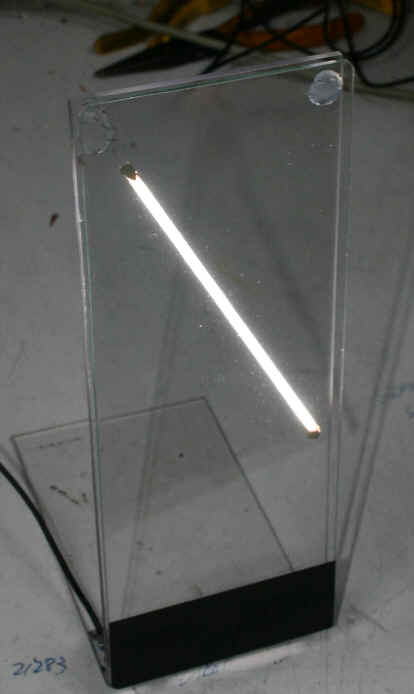

Transparent electric stuff
I recently went to anexhibition of lighting at London's V&A museum. Amongst the
exhibits were some awesome pieces by Ingo Maurer
consisting of LEDs mounted on glass, with no visible interconnections - the most
outstanding of these being a large (6x3 feet from memory) glass table, with the entire top
surface containing hundreds of white LEDs forming a star-field type effect. My immediate
reaction was "I WANT ONE!".
My second reaction was "I WANT TO MAKE ONE!". I figured out that these probably
used indium-tin oxide coating on the glass - this is what's used in LCD panels. I have in
the past experimented with splitting dead LCD panels, but found that the resistance of the
coating was a bit too high to use with LEDs. Neons may be a possibility though.
Unfortunately, as far as I know, ITO coatings can only be made using an expensive
sputtering process, so I was stuck with looking at ready-made items that could be
adapted...
Whilst idly thumbing though the RS catalogue recently, I spotted something interesting - a clear plastic sheet material with a silver conductive coating, intented for EMC shielding of display windows (RS 264-9382, supplied by Warth) I bought some to play with, and found that it had a very low surface resistivity compared to the ITO I'd looked at before, and it would be suitable for LEDs. It wasn't quite as clear as ITO glass, and is very sensitive to fingermarks, which caused very visible tarnishing.
To be useful, I had to figure out a way to etch patterns into it to form seperate
conductive areas, like PCB tracks. Due to the resistance of the coating, the tracks need
to be as wide as possible, so the method is to etch away small gaps. For simple shapes,
areas can be masked with adhesive tape, but for more complex patterns, using spray-on
photoresist of the sort used for PCB fabrication worked reasonably well.
As regards what to use for etching, I tried 2 methods - the first was to electrolytically
remove the exposed silver. This was done by connecting the film to one side of a power
supply, placing a wet tissue over the area to be etched, and using a probe connected to
the other side of the PSU to run along the lines. This worked, but the voltage was quite
critical - 6V would be rather erratic, and 12V caused severe undercutting and
over-etching.
The second method was using dilute nitric acid. This looks more promising, but the only acid I could get hold of was 10% - it worked, but took several minutes and a lot of agitation to etch through the coating - stronger acid would probably be more effective. Here's a test piece I made using two 0805 surface mount white LEDs. LED mounting and connection is by conductive epoxy.

I recently picked up some surplus touchscreen overlays, designed to go over LCD panels. These consisted of a layer of ITO coated glass, plus an ITO-coated plastic film. Tiny beads on the glass seperated the two, so the two conductive coatings touch under finger pressure.
The resistivity of this stuff was about 300 ohms/square, too high for sensible use with LEDs, but then I had the idea of using a CCFL (cold-cathode fluorescent) LCD backlight tube. This worked pretty well.
"Backslash"
Test piece using 130mm CCFL tube on ITO glass, sandwiched with plastic sheet support.

Could be some interesting effects possible using partially-silvered glass/plastic..?

More to come..!